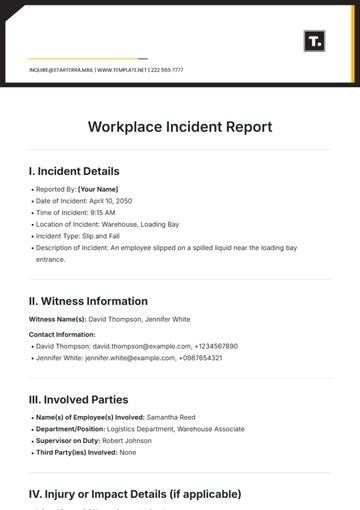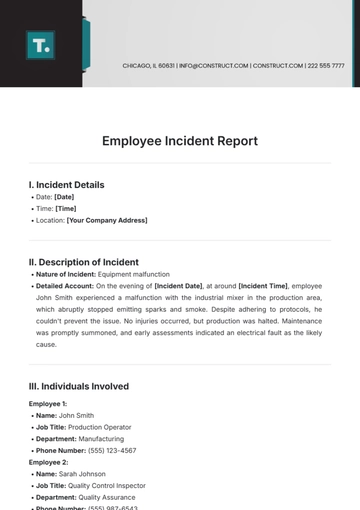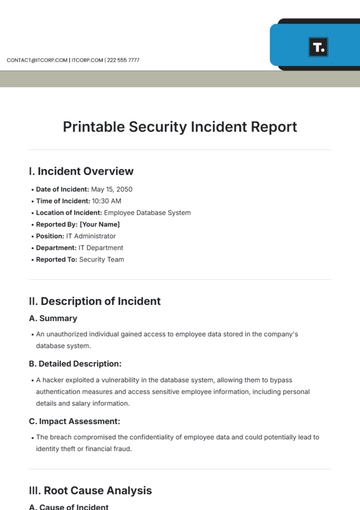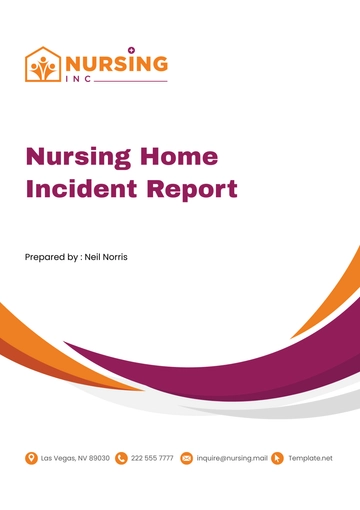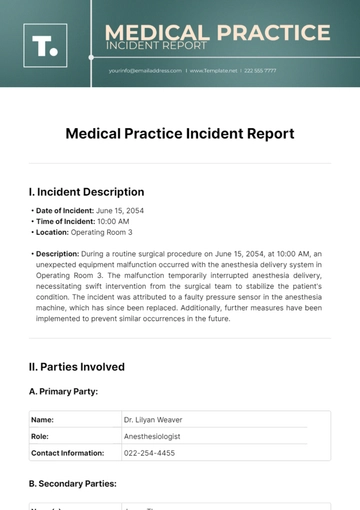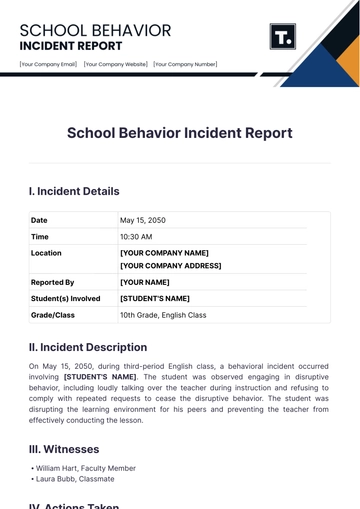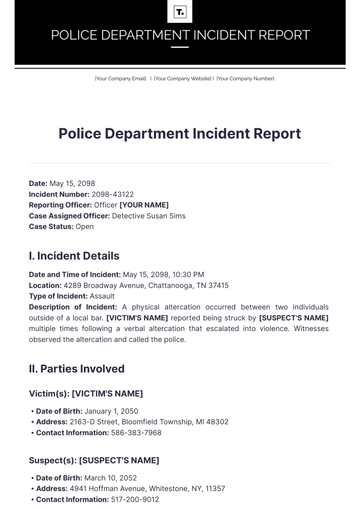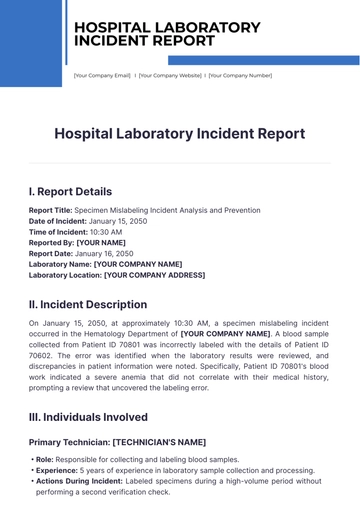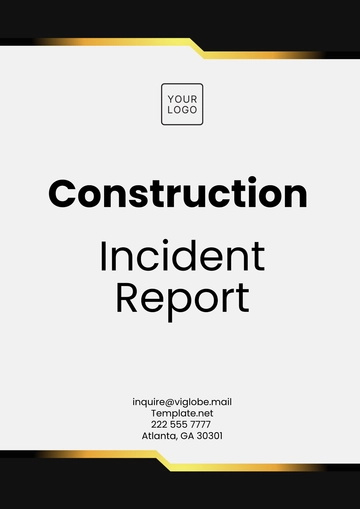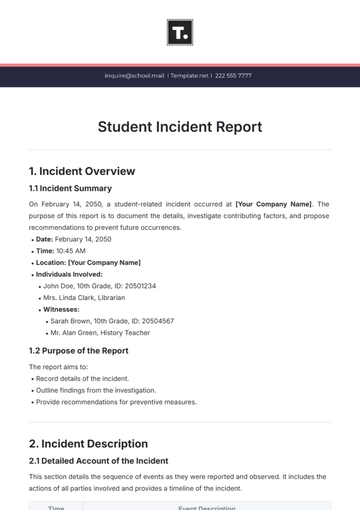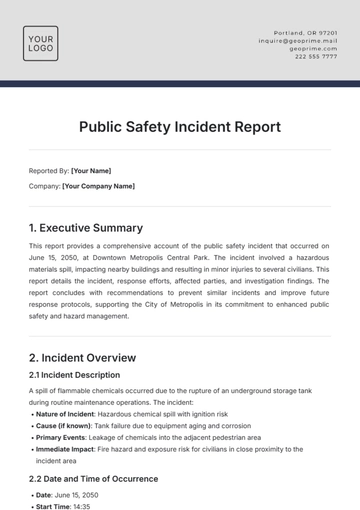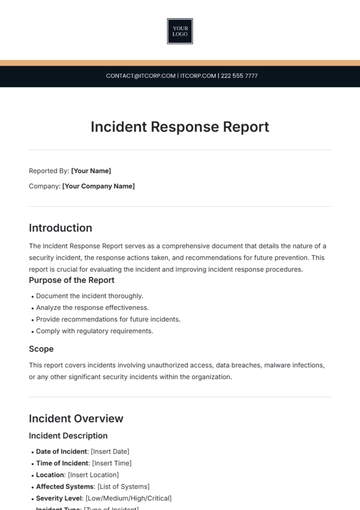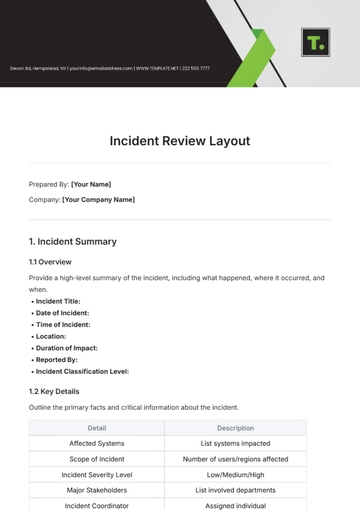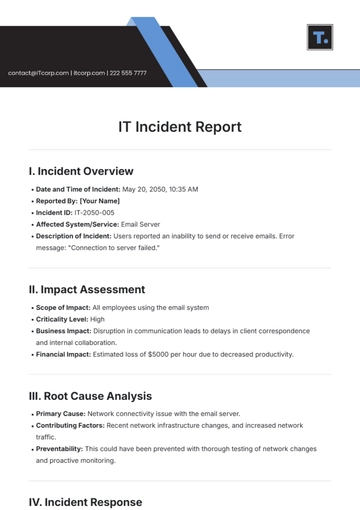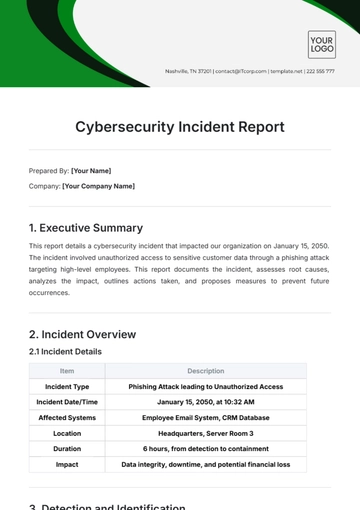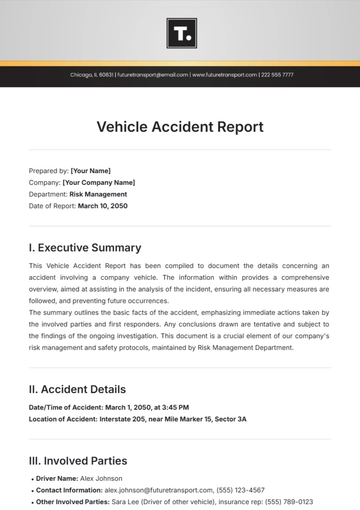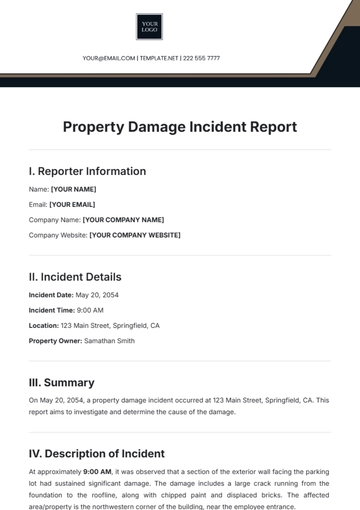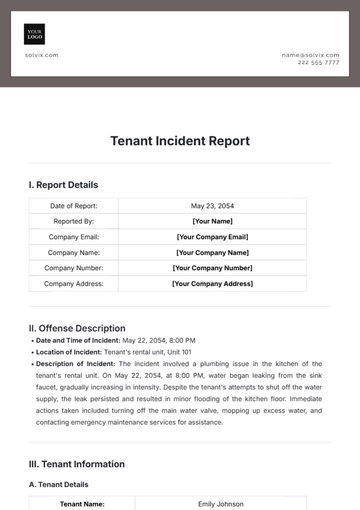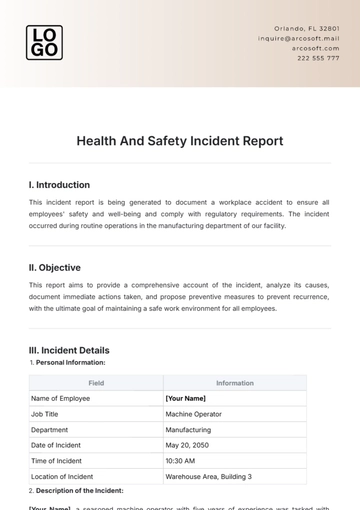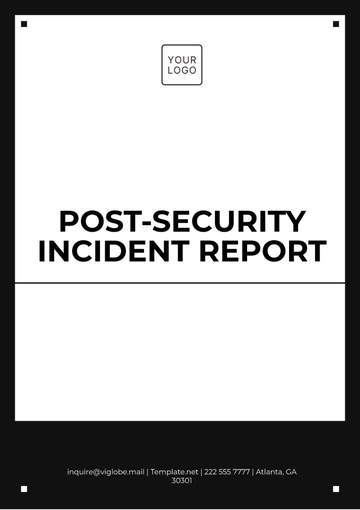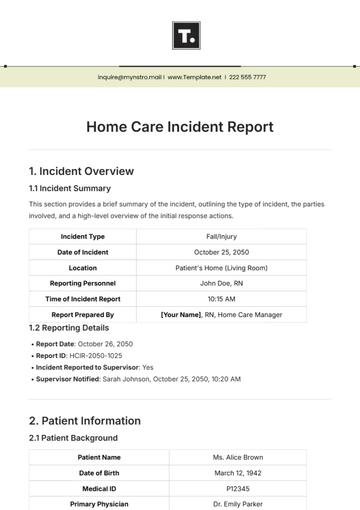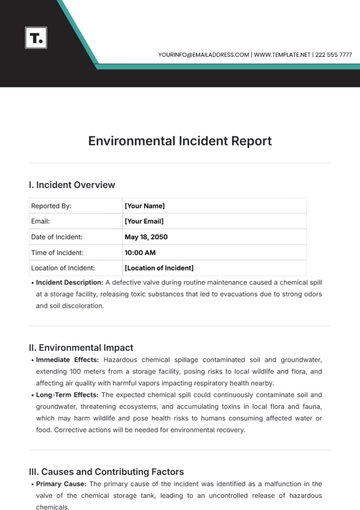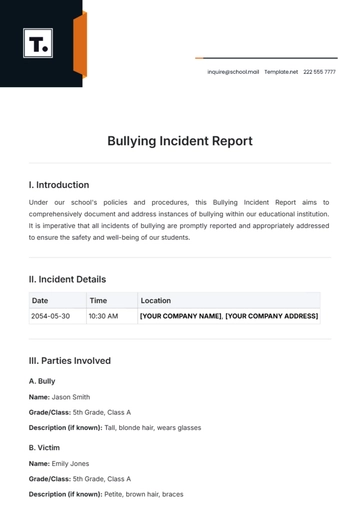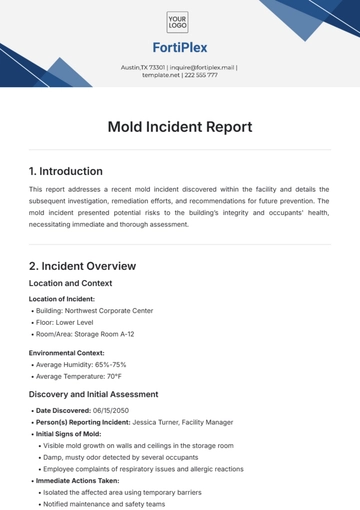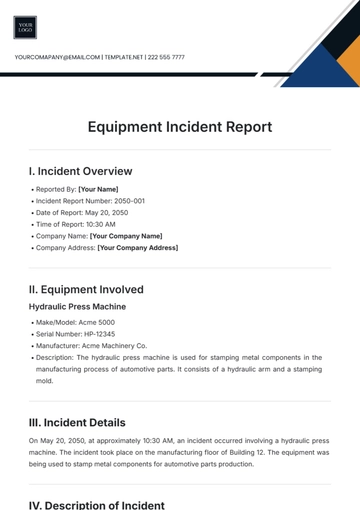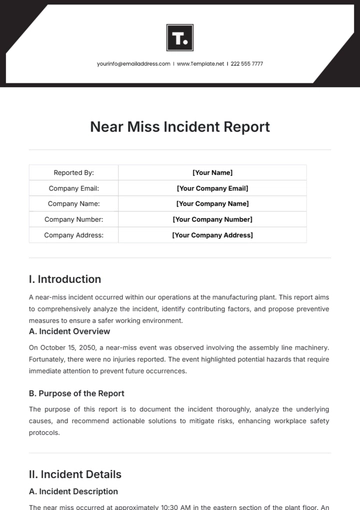Free Manufacturing Incident Report
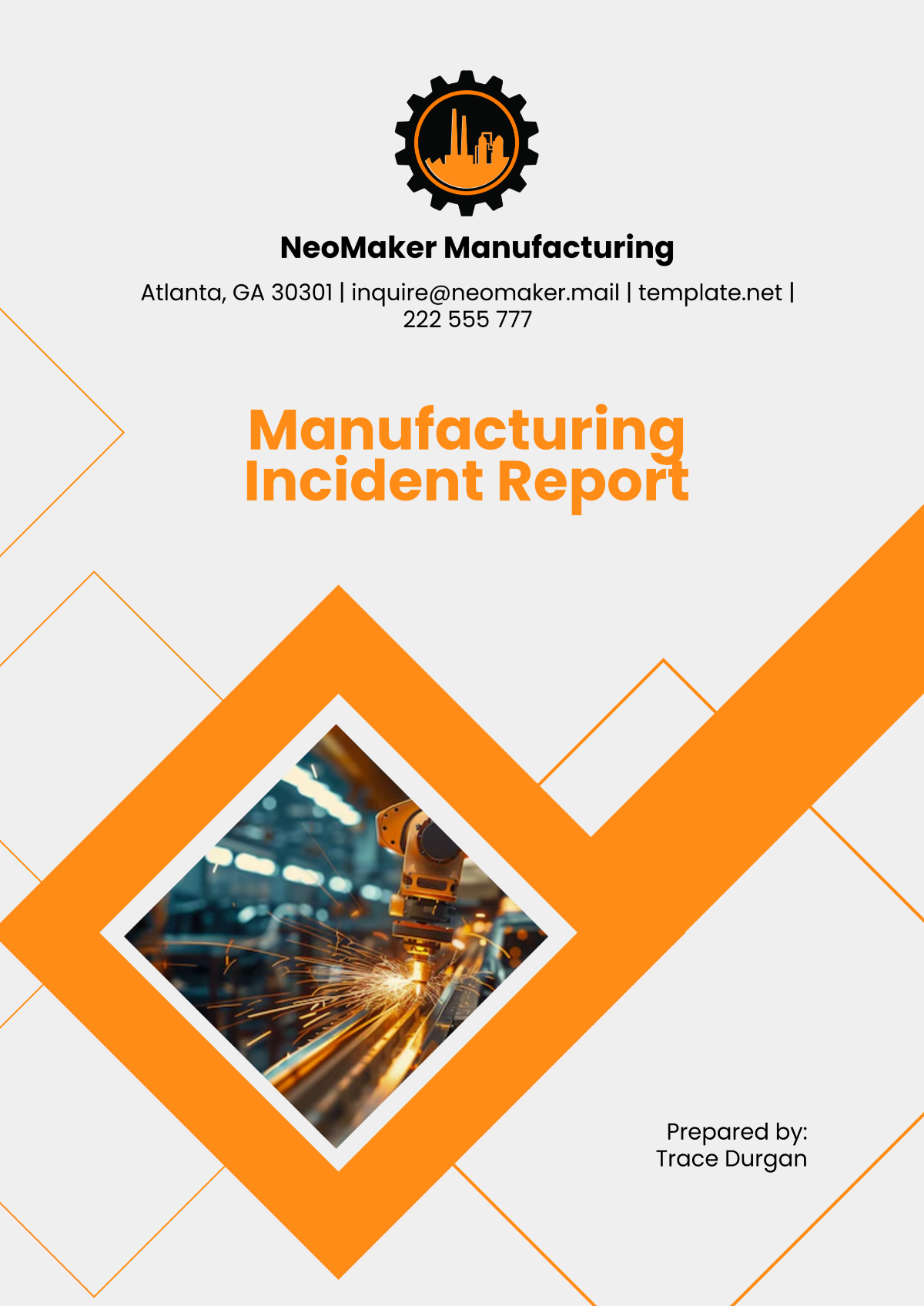
I. Introduction
This report provides an overview of workplace incidents that occurred throughout the year [2051], aiming to identify trends, analyze root causes, and recommend preventive measures for a safer working environment. This annual report serves as a foundation for continuous improvement in safety standards and operational efficiency. By learning from past incidents, we strengthen our commitment to employee well-being and compliance with regulatory requirements.
II. Summary of Incidents
This section provides an aggregated overview of the incidents reported in [2051], offering insights into frequency, severity, and affected areas. Summarizing this data highlights recurring issues and operational vulnerabilities.
A. Total Incidents
A total of [23] incidents were reported, ranging from minor injuries to significant equipment failures. This marks a slight increase from [21] incidents in [2050].
B. Severity Levels
Of the reported incidents, [18] were classified as minor, [4] as moderate, and [1] as severe. No fatalities occurred during the reporting period.
C. Departments Affected
The manufacturing department accounted for the majority of incidents, followed by maintenance, logistics, and admin.
D. Nature of Incidents
Common types included machinery malfunctions, slips and trips, chemical handling errors, and stress injuries.
III. Investigation and Analysis
Detailed investigations were conducted for all incidents to identify root causes and contributing factors. This analysis aids in preventing recurrence and improving overall safety systems.
Root Causes: The primary root causes identified included equipment wear and tear, lack of training, and procedural non-compliance. Equipment-related issues accounted for [50%] of incidents.
Human Factors: Employee errors due to insufficient training or improper risk assessment contributed to [35%] of incidents. Enhancing training programs remains a key focus area.
Procedural Gaps: Several incidents revealed lapses in following standard operating procedures, especially during machine maintenance and handling hazardous materials.
Environmental Factors: Poor lighting, cluttered workspaces, and inadequate signage were noted in certain high-risk areas, exacerbating incident risks.
Investigation Process: Investigations included interviews, site inspections, and reviews of incident records. Findings were used to implement corrective actions promptly.
IV. Incident Trends
This section analyzes trends from the 2051 incidents to provide a deeper understanding of recurring issues. Trend analysis helps prioritize interventions for maximum impact.
Incident Type | Frequency (2050) | Frequency (2051) | Percentage Change |
|---|---|---|---|
Machinery Malfunctions | 8 | 10 | +25% |
Slips and Trips | 5 | 6 | +20% |
Chemical Handling Errors | 3 | 5 | +67% |
Electrical Faults | 3 | 2 | -33% |
Ergonomic Strains | 2 | 0 | -100% |
Machinery Malfunctions: A noticeable increase in equipment-related incidents underscores the need for more rigorous maintenance schedules.
Chemical Handling: A significant rise in chemical handling errors suggests gaps in training or safety measures for hazardous materials.
Positive Trends: Ergonomic-related incidents decreased, reflecting the effectiveness of ergonomic workstations introduced in late [2050].
Slip and Trip Incidents: Incremental growth indicates the need for better housekeeping and improved flooring solutions in high-traffic areas.
Electrical Incidents: A reduction in electrical faults reflects the success of recent upgrades in electrical systems.
V. Personnel Impact
Understanding the impact of incidents on personnel helps in planning tailored interventions for affected employees and their departments.
Category | Metric | Value |
|---|---|---|
Employees Involved | Total Number | 17 |
Injuries Sustained | Total | 14 |
Medical Treatments Provided | Cases | 12 |
Time Lost per Incident | Average (Hours) | 13.7 |
Training Needs Identified | Number of Employees | 10 |
Employee Involvement: [17] employees were directly involved in incidents, with most cases occurring in the manufacturing and maintenance departments.
Injuries: The majority of injuries were minor cuts and bruises, with only [2] cases requiring extended medical leave.
Medical Attention: Onsite first aid effectively addressed [85%] of injuries, highlighting the importance of a well-equipped medical station.
Time Lost: The average time lost per incident increased slightly, emphasizing the need to address root causes promptly.
Training Opportunities: Several employees identified for additional training will participate in targeted programs in [2052].
VI. Equipment and Infrastructure
This section assesses the role of equipment and infrastructure in the year’s incidents, identifying areas for improvement.
Equipment/Infrastructure | Issue Identified | Action Taken |
|---|---|---|
Conveyor Systems | Component wear | Maintenance initiated |
Chemical Storage | Improper labeling | Labels updated |
Safety Signage | Insufficient visibility | Signs upgraded |
Emergency Stop Buttons | Inaccessible placement | Repositioning planned |
Lighting in Key Areas | Suboptimal brightness | Additional lights installed |
VII. Preventive Measures Implemented
Key preventive measures were introduced in [2051] to address incident causes and improve workplace safety.
Training Enhancements: New training modules focused on hazardous material handling and machinery operation were rolled out company-wide.
Infrastructure Upgrades: Lighting, signage, and safety equipment were improved in high-risk zones, contributing to a safer work environment.
Maintenance Schedules: A revised maintenance plan emphasizing predictive maintenance reduced equipment-related downtime.
Safety Audits: Quarterly audits identified and rectified procedural and infrastructural gaps effectively.
Employee Engagement: Safety workshops and feedback sessions were held to encourage proactive reporting and foster a safety-first culture.
VIII. Next Steps
As [Your Company Name] prepares for [2052], a structured plan is in place to address key challenges identified in this report. These steps aim to enhance safety protocols and operational efficiency.
Enhanced Incident Reporting: Introduce a digital reporting system to streamline data collection and improve analysis. A user-friendly interface will encourage timely reporting.
Training Expansion: Develop advanced training programs tailored to specific roles, focusing on high-risk tasks like chemical handling and machinery operation.
Maintenance Improvements: Increase the frequency of inspections and enforce adherence to maintenance schedules. Predictive maintenance technologies will be explored for implementation.
Infrastructure Investments: Further upgrade safety measures, including ergonomic workstations, accessible emergency equipment, and improved workspace organization.
The lessons learned in [2051] have provided valuable insights into enhancing safety at [Your Company Name]. By implementing the next steps and fostering a culture of accountability and continuous improvement, the company is well-positioned to reduce incidents and improve overall operational resilience in [2052].
- 100% Customizable, free editor
- Access 1 Million+ Templates, photo’s & graphics
- Download or share as a template
- Click and replace photos, graphics, text, backgrounds
- Resize, crop, AI write & more
- Access advanced editor
Document workplace incidents effectively with the Manufacturing Incident Report Template from Template.net. This editable and customizable template helps manufacturers capture detailed accounts of accidents. Utilize the Ai Editor Tool to tailor the template to meet specific safety and compliance standards. Ensure workplace safety and compliance by integrating this comprehensive reporting tool.
You may also like
- Sales Report
- Daily Report
- Project Report
- Business Report
- Weekly Report
- Incident Report
- Annual Report
- Report Layout
- Report Design
- Progress Report
- Marketing Report
- Company Report
- Monthly Report
- Audit Report
- Status Report
- School Report
- Reports Hr
- Management Report
- Project Status Report
- Handover Report
- Health And Safety Report
- Restaurant Report
- Construction Report
- Research Report
- Evaluation Report
- Investigation Report
- Employee Report
- Advertising Report
- Weekly Status Report
- Project Management Report
- Finance Report
- Service Report
- Technical Report
- Meeting Report
- Quarterly Report
- Inspection Report
- Medical Report
- Test Report
- Summary Report
- Inventory Report
- Valuation Report
- Operations Report
- Payroll Report
- Training Report
- Job Report
- Case Report
- Performance Report
- Board Report
- Internal Audit Report
- Student Report
- Monthly Management Report
- Small Business Report
- Accident Report
- Call Center Report
- Activity Report
- IT and Software Report
- Internship Report
- Visit Report
- Product Report
- Book Report
- Property Report
- Recruitment Report
- University Report
- Event Report
- SEO Report
- Conference Report
- Narrative Report
- Nursing Home Report
- Preschool Report
- Call Report
- Customer Report
- Employee Incident Report
- Accomplishment Report
- Social Media Report
- Work From Home Report
- Security Report
- Damage Report
- Quality Report
- Internal Report
- Nurse Report
- Real Estate Report
- Hotel Report
- Equipment Report
- Credit Report
- Field Report
- Non Profit Report
- Maintenance Report
- News Report
- Survey Report
- Executive Report
- Law Firm Report
- Advertising Agency Report
- Interior Design Report
- Travel Agency Report
- Stock Report
- Salon Report
- Bug Report
- Workplace Report
- Action Report
- Investor Report
- Cleaning Services Report
- Consulting Report
- Freelancer Report
- Site Visit Report
- Trip Report
- Classroom Observation Report
- Vehicle Report
- Final Report
- Software Report
